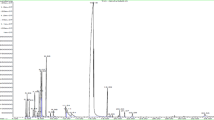Abstract
The essential oils obtained by hydrodistillation from the Monarda genus plants cultivated in Belarus were investigated. Using the technique of gas-liquid chromatography, essential oil components were identified and quantified. The dominant components of the essential oils were thymol (up to 27%), carvacrol (up to 29%), γ-terpinene (up to 22%), and p-cymene (up to 35%). The distribution of dominant components of Monarda essential oil depending on the plant chemotype and the method of plant material preparation was shown. Antimicrobial activity of Monarda essential oil against Gram-positive and Gram-negative bacteria test cultures was revealed. Gram-positive bacterial cultures were more sensitive to the inhibitory effect of Monarda essential oils. Antimicrobial properties of dominant components (thymol, carvacrol, γ-terpinene, and p-cymene) were investigated. The effect of dominant component concentration on the antimicrobial properties of Monarda essential oils was established.


Similar content being viewed by others
REFERENCES
Kharchenko, V.A., Bespal’ko, L.V., Gins, V.K., Gins, M.S., and Baikov, A.A., Monarda—a valuable source of biologically active compounds, Ovoshchi Ross., 2015, no. 1, pp. 31–35.
Fedotov, S.V., Monarda essential oils of Monarda fistulosa L., Monarda didyma L., Monarda citriodora Cervantes ex Lag., their chemotypes and biological activity, Sb. Nauch. Tr. GNBS, 2015, vol. 141, pp. 131–147.
Vinogradov, B., Vinogradova, N., and Golan, L., Aromaterapiya. Uchebnyi kurs. Entsiklopedicheskii kurs (Aromatherapy. School Course. Encyclopedic Course), Fultus Corp., 2006.
Lapina, A.S., Varina, N.R., Kurkin, V.A., Avdeeva, E.V., Ryazanova, T.K., Ryzhov, V.M., and Ruzaeva, I.V., Monarda fistulosa as a promising source of medicines, Sb. Nauch. Tr. GNBS, 2018, vol. 146, pp. 175–178. https://doi.org/10.25684/NBG.scbook.146.2018.28
Carovic-Stanko, K., Petek, M., Grdisa, M., Pintar, J., Bedekovic, D., Herak, Custic, M., and Satovic, Z., Medicinal plants of family Lameacea as functional foods—a review, Czech J. Food Sci., 2016, vol. 34, no. 5, pp. 377–390. https://doi.org/10.17221/504/2015-CJFS
Pandey, A.K., Kumar, P., Singh, P., Tripathi, N., and Bajpal, V.K., Essential oils: Sources of antimicrobials and food preservatives, Front. Microbiol., 2017, vol. 7, p. 2161. https://doi.org/10.3389/fmicb.2016.02161
Bedulenko, M.A., Introduction, ecological aspect and modern directions of study and application of the medicinal, spicy-aromatic and essential oil plant Monarda fistulosa L., Tr. Belorus. Univ., 2013, vol. 8, no. 2, pp. 52–60.
Mazza, G. and Marshall, H.H., Geraniol, linalool, thymol and carvacrol-rich essential oils from Monarda hybrids, J. Essential Oil Res., 1992, vol. 4, no. 4, pp. 395–400. https://doi.org/10.1080/10412905.1992.9698091
Anishchenko, I.U., Pupykina, K.A., Krasyuk, E.V., and Zhigunov, O.Yu., The component structure of essential oils from some representatives of the genus Monarda L. introduced into the republic of Bashkortostan, Izv. Ufim. Nauch. Tsentra RAN, 2017, no. 3, pp. 71–76.
Ismailova, E.T., Shemshura, O.N., and Seitbattalova, A.I., Phenolic compounds of plants of the Monarda sorts, Dokl. Nats. Akad. Nauk Resp. Kazakhstan, 2015, vol. 6, no. 304, pp. 110–118.
Nikitina, A.S., Aliev, A.M., Fes’kov, S.A., and Nikitina, N.V., Component composition of essential oil of Monarda fistulosa L. grass from the collection of Nikitsky botanical garden, Khim. Rastit. Syr’ya, 2018, no. 2, pp. 55–62. https://doi.org/10.14258/jcprm.2018023295
Oparin, R.V., Pokrovskii, L.M., Vysochina, G.I., and Tkachev, A.V., Study of the chemical composition of the essential oil of Monarda fistulosa L. and Monarda didyma L. cultivated in Western Siberia, Khim. Rastit. Syr’ya, 2000, no. 3, pp. 19–24.
Myadelets, M.A., Domracheva, D.V., Kriklivaya, A.N., and Vysochina, G.I., Dependence of the composition of essential oil of Monarda didyma L. (Lamiaceae) from the age and nature of plant materials, Khim. Rastit. Syr’ya, 2014, no. 1, pp. 215–219.
Motarelli, P., Epifano, F., Minardi, P., di Vito, M., Modesto, M., Barbanti, L., and Bellardi, M.G., Chemical composition and antimicrobial activity of essential oils from aerial parts of Monarda didyma and Monarda fistulosa cultivated in Italy, J. Essent. Oil Bear. Plants, 2017, vol. 20, pp. 76–86. https://doi.org/10.1080/0972060X.2016.1278184
Xu, J., Zhou, F., Ji, B.-P., Pei, R.-S., and Xu, N., The antibacterial mechanism of carvacrol and thymol against Escherichia coli, Lett. Appl. Microbiol., 2008, vol. 47, pp. 174–179.
Memar, M.Y., Raei, P., Alizadeh, N., Aghdam, M.A., and Kafil, H.S., Carvacrol and thymol: Strong antimicrobial agents against resistant isolates, Rev. Med. Microbiol., 2017, vol. 28, no. 2, pp. 63–68. https://doi.org/10.1097/MRM.0000000000000100
Adebayo, O., Belanger, A., and Khanizadeh, S., Variable inhibitory of essential oils of three Monarda species on the growth of Botrytis cinerea, Canad. J. Plant Sci., 2013, vol. 93, no. 6, pp. 987–995. https://doi.org/10.4141/CJPS2013-044
Ricci, D., Epifano, F., and Fraternale, D., The essential oil of Monarda didyma L. (Lameacea) exerts phytotoxic activity in vitro against various weed seeds, Molecules, 2017, vol. 22, no. 2, pp. 222–232. https://doi.org/10.3390/molecules22020222
Katoch, M., Phull, S., Vaid, S., and Singh, S., Diversity, phylogeny, anticancer and antimicrobial potential of fungal endophytes associated with Monarda citriodora L., BMC Microbiol., 2017, vol. 17, p. 44. https://doi.org/10.1186/s12866-017-0961-2
Contaldo, N., Bellardi, M.G., Cavicchi, L., Epifano, F., Genovese, S., Curini, M., and Bertaccini, A., Phytochemical effects of phytoplasma infections on essential oil of Monarda fistulosa L., Bull. Insectol., 2011, vol. 64, pp. 177–178.
Nostro, A., Blanko, A.K., Cannatelli, M.A., Enea, V., Flamini, G., Morelli, I., Sudano Roccaro, A., and Alonzo, V., Susceptibility of methicillin-resistant staphylococci to Oregano essential oil, carvacrol and thymol, FEMS Microbiol. Lett., 2004, vol. 230, pp. 191–195. https://doi.org/10.1016/S0378-1097(03)00890-5
Vale-Silva, L., Silva, M.J., Oliveira, D., Goncales, M.J., Cavaleiro, C., Salgueiro, L., and Pinto, E., Correlation of the chemical composition of essential oils from Origanum vulgare subsp. virens with their in vitro activity against pathogenic yeasts and filamentous fungi, J. Med. Microbiol., 2012, vol. 61, pp. 252–260. https://doi.org/10.1099/jmm.0.036988-0
Author information
Authors and Affiliations
Corresponding author
Ethics declarations
The authors declare no conflicts of interest.
This article does not contain any research involving humans or animals as research objects.
Additional information
Translated by N. Onishchenko
Rights and permissions
About this article
Cite this article
Kovalenko, N.A., Leontiev, V.N., Supichenko, G.N. et al. Antimicrobial Properties of Essential Oils of the Monarda Genus Plants Cultivated in Belarus. Russ J Bioorg Chem 48, 1448–1453 (2022). https://doi.org/10.1134/S1068162022070123
Received:
Revised:
Accepted:
Published:
Issue Date:
DOI: https://doi.org/10.1134/S1068162022070123



